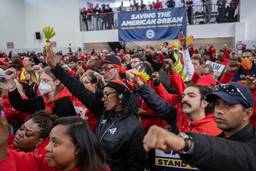The reasons for Stern’s resignation as SEIU president are unclear. His troubled legacy isn’t.
He could have been the Walter Reuther organized labor has hungered for as it has sputtered and shriveled.
The leader with new ideas and the energy to make them work. The leader who could link organized labor with social issues with a passion that would renew unions’ credentials as a movement not just for its own.
From his start as the head of the Service Employees International Union (SEIU) 15 years ago, Andy Stern sent the message that he was a guy with an independent mind and that he was going to share his thoughts.
And amid his AFL-CIO colleagues, he did, indeed, speak more candidly than most heads of large U.S. unions about labor’s downward spiral.
Stern was critical of unions that poached on others’ turf to gain members in industries where they had little clout or know-how, that didn’t spend enough or even any money on organizing, that didn’t make their voices heard and that didn’t have the guts and flexibility to take chances.
And he was right.
He was also impatient with talk of union democracy because he didn’t think organized labor had the time for it. He considered it more important to build up a union’s ranks and to gain a foothold in a poorly organized industry than to make sure that everyone had a voice.
Stern’s rationale was that union democracy doesn’t always guarantee you better contracts, which are what union members want and what unions need to take care of.
Megalocals and media makeovers
He never backed down on that. And that strategy, I think, became a tragic hang-up as complaints rose about small locals cobbled together into giant locals and top-down leadership that brushed aside the need to let workers know about everything in their contracts.
When details emerged about contracts that the union had agreed to keep secret and which gave incredible powers to the companies, he was not the least apologetic. It was better, he said, to have a foot in the door than to wait forever on the outside.
Stern believed firmly in labor’s need to tell its story and that is why the union pumped up its outreach to the news media to a level unrivaled by any other union.
Unlike some union leaders who either wouldn’t sit down face to face with a journalist or wouldn’t do it unless their handlers had everything under control, Stern wasn’t that way when he took over the SEIU in 1995.
He was so accessible his voice almost became the only other one available when I went searching for union leaders’ comments as the Chicago Tribune’s labor reporter. He didn’t preach or recite memorized slogans. He was calm and thoughtful and I was impressed. But I often wondered where he and the SEIU were headed.
As the union’s successes grew, so did its troubles. Stern was still available — but now there were media savvy assistants on hand or waiting nearby to manage the message.
The troubled schism
Stern’s impatience with the AFL-CIO made sense, but the result wrought by his action has been terribly toxic for organized labor.
The AFL-CIO suffered a deep financial loss and a severe cutback in its ability to look out for the interests of workers and unions in Washington when Stern led his gang off to form their own federation: Change to Win.
At the same time, the new federation didn’t attempt to copy the AFL-CIO’s role as labor’s central voice on pensions, workplace safety and a whole of other issues that have only become more worrisome for workers lately.
That left a large hole.
Nor did Stern’s federation do a better job of organizing, as it had promised.
One of the myths about the break-up was that the dissidents wanted to spend more on organizing and less on politics. That was a myth that somehow found a life among news reporters and union leaders.
The reality was that SEIU did spend more organizing — but also spent even more on politics. Some of it worked, and Stern’s close ties with the White House are proof of that. And sometimes it backfired; witness the union’s support for disgraced and impeached Illinois Governor Rod Blagojevich.
No other unions joined the dissidents in their new federation, as Change to Win leaders had predicted. And the new federation’s own unity soon crumbled.
What went wrong?
When the SEIU helped launch an alternative battle with Wal-Mart while the United Food and Commercial Workers was taking on the retail giant, the UFCW was not thrilled.
But the most glaring break with union solidarity came when the SEIU took sides in the battle between the hotel workers and garment workers unions as their merger collapsed. The SEIU helped the garment workers in their trench warfare with the hotel workers. It was exactly the kind of communal backstabbing that Stern had long complained about.
Buzzing with Stern’s energy and imagination, the SEIU signed up new members, found news friends, reached out to global unions and wisely figured out ways to fight global companies. It relied, for example, on Spanish-speaker janitors from Chicago instead of organizers to win a major battle with janitorial firms in Houston.
So what went wrong? What led to Stern’s resignation last week amid a swirl of good and bad news? Was the impatience to get things done in a hurry what brought on so many problems?
Was it the willingness to make deals for the sake of moving on, such as embracing the Teamsters, who had crushed several internal reform drives before Stern welcomed them into the Change to Win group?
Whatever it was, the fact is that Stern could have easily been the next Walter Reuther. It just didn’t work out.
A former labor writer for the Chicago Tribune, Stephen Franklin is a Pulitzer Prize finalist and an adjunct professor at the University of Illinois Urbana-Champaign School of Labor and Employment Relations.







